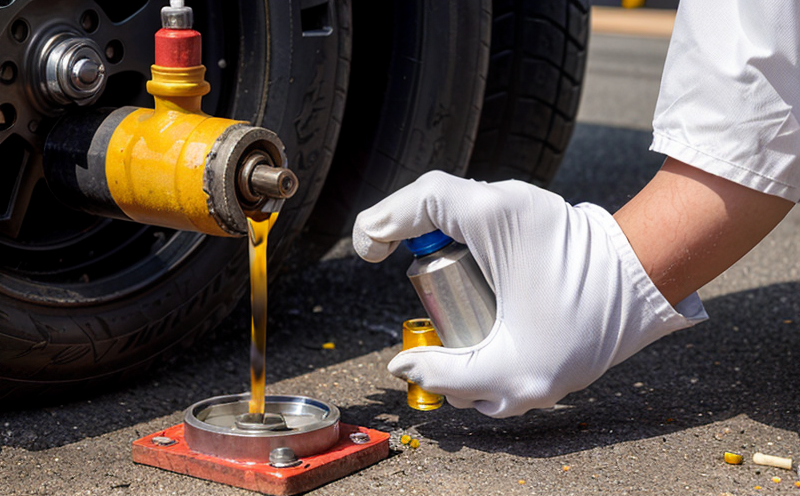ASTM D5184 Oil Analysis of Insolubles by Membrane Patch
The ASTM D5184 test method provides a standardized procedure for quantitatively analyzing insoluble materials in marine and ship fuel oils, lubricants, and other petroleum products. This analysis is critical to understanding the condition and quality of these fluids, particularly when they are subjected to high operational stresses such as extreme temperatures, pressures, and abrasive environments.
The membrane patch technique employed in this ASTM test involves filtering a known volume of oil through a porous membrane filter. The insoluble materials retained on the filter are then dried thoroughly, weighed, and quantified based on their mass relative to the total volume of oil analyzed. This allows for precise measurement of contaminants such as wear metals, soot, sediment, and other particulate matter.
The ASTM D5184 test is widely used by quality managers, compliance officers, R&D engineers, and procurement professionals in the marine and ship industry. The insights gained from this analysis help ensure that fuel oils and lubricants meet stringent performance requirements, enhancing operational reliability and safety of ships and other maritime equipment.
The test procedure involves a series of steps to prepare specimens for analysis:
- Sampling: Collect representative samples from the oil or lubricant in question.
- Filtering: Filter these samples through a membrane patch with a specified pore size using vacuum filtration.
- Drying: Dry the filter and retained materials completely at room temperature to ensure accurate mass measurement.
- Weighing: Accurately weigh the dried filter and its contents on high-precision analytical balances.
The results of this analysis are reported as a percentage by volume or weight, providing valuable data for monitoring fuel quality over time. This information is crucial for identifying potential issues early and preventing costly downtime or repairs. The ASTM D5184 method ensures consistent and reliable test results, which can be used to compare different batches of oil or track the degradation of lubricants.
In addition to ensuring compliance with industry standards, this analysis also aids in optimizing maintenance schedules by providing insights into wear patterns and potential contamination sources. This proactive approach helps extend the life of critical components and reduces the risk of equipment failure at sea.
Why It Matters
The ASTM D5184 test method is vital for maintaining the integrity and performance of marine and ship fuel oils, lubricants, and other petroleum products. In this high-pressure environment, even small amounts of insoluble materials can have significant impacts on system efficiency and reliability.
- Preventative Maintenance: By regularly analyzing oil samples using ASTM D5184, maintenance teams can identify potential issues before they escalate into major problems.
- Enhanced Efficiency: Clean, contaminant-free fuel oils and lubricants ensure optimal engine performance, reducing energy consumption and operational costs.
- Safety Improvements: Contamination in marine fuels can lead to equipment failures that pose serious safety risks. ASTM D5184 helps mitigate these risks by providing early warnings of potential issues.
- Regulatory Compliance: Many international maritime regulations require compliance with specific quality standards for fuel and lubricants, making this test essential for maintaining regulatory adherence.
The test results from ASTM D5184 are indispensable tools for decision-makers in the marine industry. They provide actionable insights that can be used to improve operational efficiency, enhance safety, and reduce maintenance costs. By leveraging these data points, companies can optimize their fuel and lubricant usage, ensuring that they meet both current and future regulatory requirements.
Customer Impact and Satisfaction
The implementation of ASTM D5184 oil analysis by membrane patch significantly enhances customer satisfaction in the marine industry. By providing accurate and reliable data on fuel quality, this method ensures that clients receive products that meet or exceed specified performance criteria.
- Improved Product Quality: Regular ASTM D5184 testing helps ensure that fuels and lubricants are free from excessive contaminants, thus improving overall product quality.
- Enhanced Reliability: By detecting potential issues early, this analysis minimizes the risk of equipment failures, thereby enhancing operational reliability.
- Cost Savings: Preventive maintenance strategies informed by ASTM D5184 data can lead to reduced downtime and lower overall maintenance costs.
- Environmental Benefits: Cleaner fuels contribute to more efficient operations, which in turn reduce emissions and environmental impact.
The benefits of this analysis extend beyond just the marine industry. It also supports broader efforts to improve sustainability and efficiency across all sectors that rely on petroleum products for their operations.
Customer satisfaction is paramount in any business relationship, especially within industries where equipment downtime can have severe consequences. The insights gained from ASTM D5184 testing help ensure consistent performance, reliability, and safety, thereby fostering long-term customer loyalty.
Competitive Advantage and Market Impact
The adoption of ASTM D5184 oil analysis by membrane patch provides a competitive edge in the marine industry. This method not only ensures compliance with stringent regulatory requirements but also offers valuable data that can be used to optimize operational processes.
- Regulatory Compliance: By adhering to this international standard, companies demonstrate their commitment to quality and safety, which is crucial for maintaining a positive reputation in the global market.
- Data-Driven Decisions: The precise data provided by ASTM D5184 allows businesses to make informed decisions regarding fuel selection, maintenance scheduling, and operational adjustments.
- Innovation Support: Regular testing with this method can help identify trends in fuel quality over time, which is invaluable for R&D teams seeking to innovate and improve product offerings.
- Potential for Cost Reduction: Early detection of contaminants through ASTM D5184 analysis can prevent costly repairs and replacements, ultimately reducing operational expenses.
In a highly competitive market where reliability and efficiency are key differentiators, the ability to provide accurate and consistent fuel quality data is a significant advantage. This method also supports broader industry efforts towards sustainability by promoting cleaner energy practices.
By leveraging ASTM D5184 oil analysis by membrane patch, companies can stay ahead of regulatory changes, enhance operational performance, and build stronger relationships with their customers. The insights gained from this testing contribute to a more efficient and sustainable future for the marine industry.





